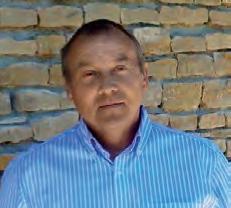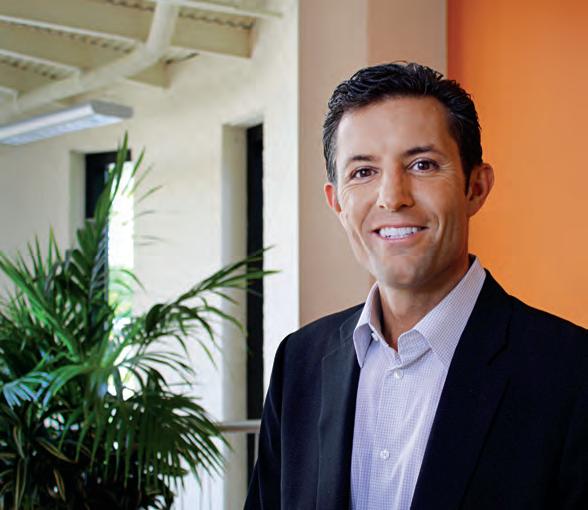
9 minute read
Success With Innovation Requires Ability to Execute
from Raven Issue No. 19
Louis Foreman is a prolific inventor, product developer, innovation enthusiast and small business entrepreneur. Over the span of 20 years, Foreman has created nine successful startups and has been directly responsible for the creation of more than 20 others.
In recent years, he’s been called upon by Congress to share his point of view on patent reform, by USA Today for commentary on entrepreneurship and often to address schools and universities to propel the advancement of innovation for all ages. Foreman is founder and CEO of Enventys, a Charlotte, N.C.-based company that assists its clients with all aspects of product development, from research and design through prototyping and go-to-market strategies. He is also the creator of Everyday Edisons, a public television series that documents the product development process, and founder of EdisonNation.com, an online community that assists inventors with bringing their ideas to market.
Advertisement
He recently visited the Glen Raven Concept Gallery to discuss innovation.
Why is innovation important to business today?
Innovation is critical today not only for companies, but also for consumers because innovation brings new capabilities, new products, new challenges and new solutions to the marketplace. More than 50 percent of consumer products today are less than two years old, which tells us that the pipeline of innovation is flowing much faster and that consumers are no longer satisfied buying today what they bought yesterday.
For many companies, innovation can be a game changer. Start-up companies can create a level playing field with much larger competitors by inventing a new product or service; established companies can use innovation to gain a competitive advantage or to diversify into new markets. Without continual innovation, brands run the risk of losing their differentiation and becoming commodities.
Louis Foreman
What is the single biggest mistake that companies make with innovation?
Many companies confuse brainstorming with innovation. These companies believe that if you get a bunch of people together in a room, magic will happen. Or better yet, you take a group of your employees off-site to a resort or a rope course where they will be free to develop creative new ideas.
“True innovation is all about using creative ideas to develop new products or services that you take to market profitably.”
Louis Foreman
The reason this approach doesn’t work is you just end up with a bunch of creative ideas. After people return to their jobs, the emails start coming in and the meetings pile up and nothing happens with those great ideas. True innovation is all about using creative ideas to develop new products or services that you take to market profitably. True innovation is all about the execution.
What are some of the other challenges that companies face with innovation?
There are many challenges to successful innovation. Expectations can be too high for quick results that will increase next quarters’ earnings; creative ideas are starved by the lack of people and financial resources; fear of failure prevents many organizations from taking the risks that innovation requires; participation in innovation is often limited to only a few people in the R&D department rather than throughout the organization; companies attempt to create a new product or service that falls outside of their core competencies.
Fear of failure is a major obstacle to innovation for many companies. Failure is simply part of innovation, and if you are not failing you are probably not reaching far enough. You certainly want to limit your failures, but equally important look at failure as one option that didn’t work, learn from the experience and move along to an option that will enable you to achieve success.
What is the key to success with innovation?
Success with innovation requires establishing a culture that understands what innovation is and what innovation isn’t.
Great ideas can come from anywhere, including your customers who interact with your products every day. Successful innovation requires being able to identify great ideas and then being able to execute on those great ideas. The difference between creating a great idea and making money from a great idea is all about execution.
Surround yourself with talent that can design, engineer, manufacture, market, brand and distribute your new product or service. You can’t do it by yourself.
Innovation isn’t just something that you talk about. Innovation is something that you do. You need to have the right people, the right resources and the right leadership. When you are truly innovative you are going to disrupt.
Innovative Ideas From Everyday Edisons and Edison Nation
Below are just a few of the innovative ideas that have been taken to market in recent years, thanks to the work of Louis Foreman and Everyday Edisons and Edison Nation: Eggies
While standing over her stove watching the water boil over a few eggs, Betsy Kaufman imagined a heat-resistant, egg-shaped container that would prevent hairline fractures in egg shells so she wouldn’t have to labor over peeling egg shells. You’ll find Betsy’s “Eggies” idea on store shelves at many leading retailers.
Gyro Bowl
When Brad and Melinda Shepard’s son couldn’t keep his Cheerios from spilling, these young parents took matters into their own hands. They developed a prototype for a snack bowl that could swivel, dip and oscillate to withstand the quick movements of a busy toddler. This idea has become an infomercial bestseller.
Mister Steamy
With combined backgrounds in acting, restaurant and bar owning, Will Howe and Ric Payne understood how much active lifestyles leave little room for mundane household tasks like doing laundry. Their idea, the Mister Steamy dryer ball, is a solution for those with limited time or just lacking the will to fold and put away clothes when the dryer buzzes.
Pressix technology
Franklin Ramsey’s great idea was for a trash can that holds the trash bag securely in place, which resulted from his experience assisting his wife with her commercial janitorial business. His invention, which is featured in high-end trash cans, keeps trash can liners in their proper place without ever having to tie, knot or tear a single bag.
“The one thing that truly makes us different is our ability to serve as a one-stop shop beginning with fiber design and carrying through with value-added dyeing, printing, finishing, coating or laminating.”
Brookwood companies pursuing one-stop-shop approach for technical textiles
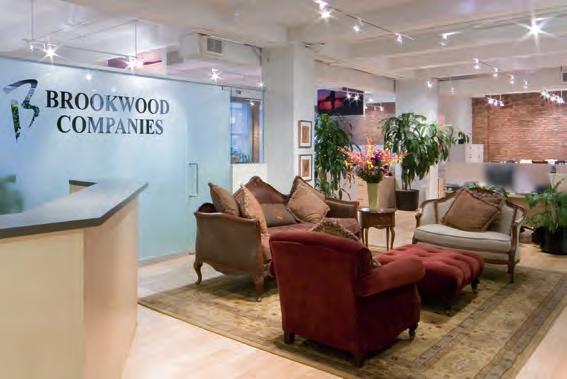
As Amber Brookman scanned the textile industry for entrepreneurial opportunities in the early 1980s, she identified a niche that led to the creation of one of the industry’s most diversified companies that is providing value-added products for markets as diverse as military and medical, active wear and law enforcement.
“Before forming Brookwood Companies, I met with spinners, weaving mills, converters and finishers and wondered why everything in this industry was so disjointed,” said Brookman, whose career experience before creating her own company in 1984 had included service with Allied Chemical. “The concept for Brookwood Companies would be a one-stop shop for the textile industry in which we could serve our customers throughout the process, from the engineering of fibers to product design, manufacturing and marketing.”
Brookwood Companies has grown into a globally recognized expert in dyeing, printing, finishing, coating and laminating technical products using synthetic fabrics, primarily nylon. The company’s technical fabrics include the U.S. military, U.S. Postal Service and law enforcement as well as protective work wear. Brookwood’s consumer products are innovative and fashion-forward offerings encompassing active wear, outerwear, luggage and specialty bag markets.
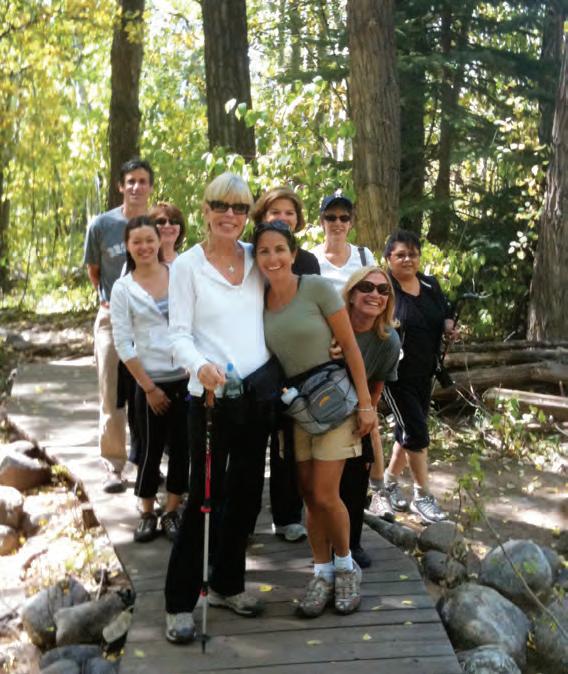
You will also find Brookwood Companies’ fabrics throughout the healthcare industry, including blood pressure cuffs, wound care mattresses, and pneumatic foot and leg wraps. Industrial fabrics from Brookwood are used in specialty end products such as filtration, airline safety equipment, and coating and laminating substrates. The company also operates a roll goods division that serves customers who need fast delivery of fill-in yardage.
Among Brookwood’s trade partners is Glen Raven, which since 1989 has been a resource for woven nylon fabrics manufactured by Glen Raven’s Burnsville, N.C., manufacturing center. These fabrics find their way into a broad array of Brookwood’s finished products for many of its key markets. Brookwood Companies is headquartered in New York with manufacturing centers in Connecticut and Rhode Island and a distribution center in California.
“Given the cyclical nature of textile markets, product diversification has been one of our core strengths over the years,” >
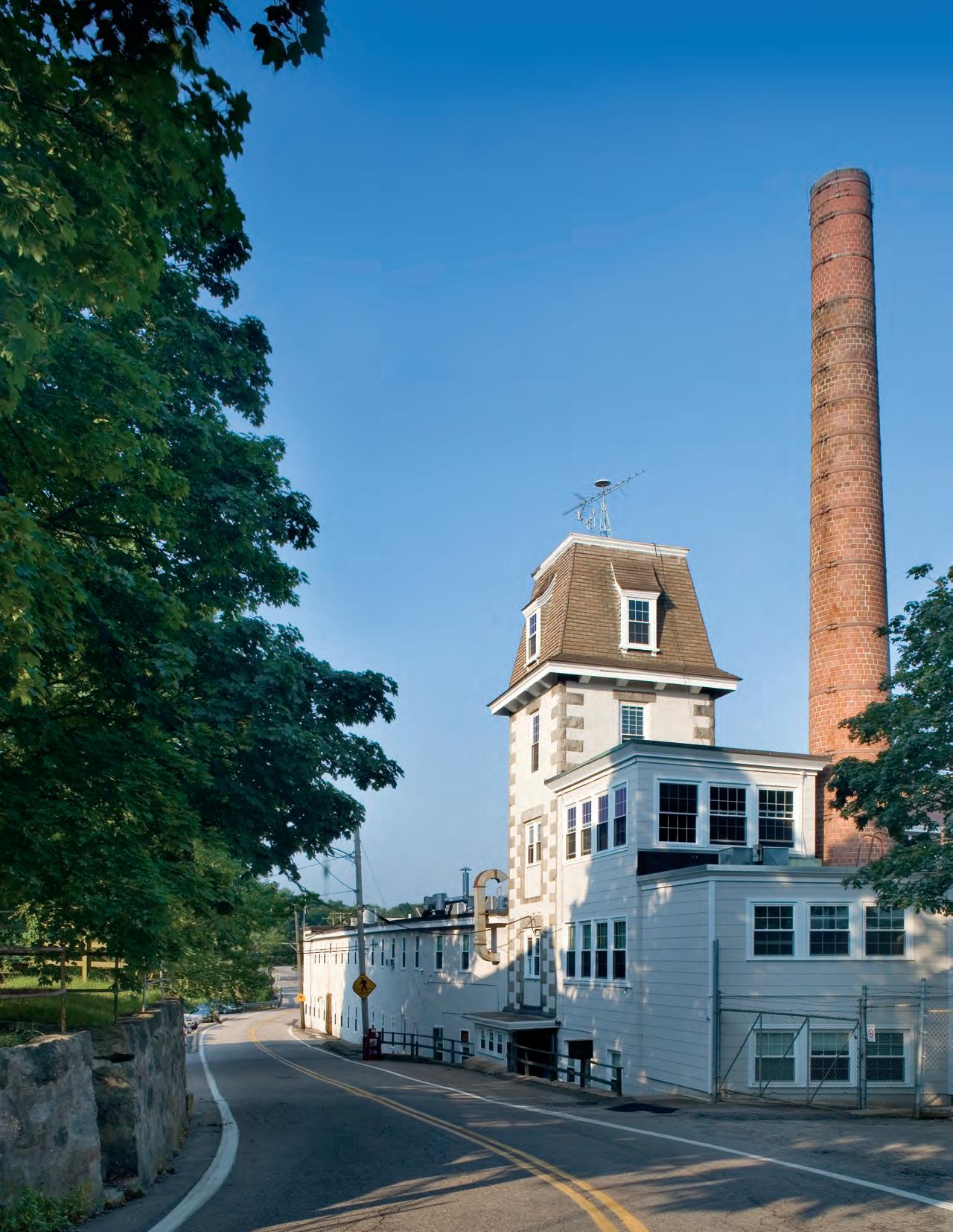
Brookman said. “While we cover a wide range of applications, there are unifying features of our company, including a high level of technical expertise working with synthetic fibers. The one thing that truly makes us different is our ability to serve as a one-stop shop beginning with fiber design and carrying through with value-added dyeing, printing, finishing, coating or laminating.”
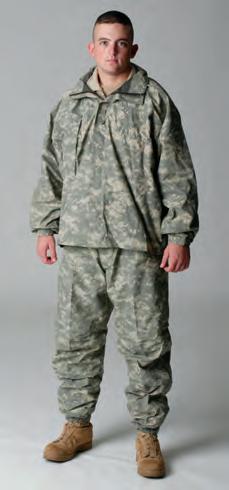
Another secret to success for Brookwood Companies has been a strong culture that is reflected in its mission statement adopted in 1984. This culture is demonstrated in dramatic fashion by an open floor plan at corporate headquarters in New York where no one has a private office, including Brookman.

“We have an egalitarian work environment in which everyone is treated equally, and individuals in all jobs are treated with respect no matter the level within the organization,” she said. “Our company is ageless, genderless and raceless; if you are smart and work hard, you are welcome here. We offer generous benefits and flexible work schedules; we like to think that we created a Google-like work environment long before Google was a word in the average vocabulary.”
The egalitarian environment has resulted in strong workforce retention with many Brookwood associates having served with the company since its founding. Other elements of the culture include a focus on giving back to the community and environmental stewardship.
“Instead of taking us to lunch or on golf outings, we ask that our trade partners donate the money they would normally spend entertaining us on the charities we support,” said Jeff Harris, executive vice president with Brookwood. “Our core values are to treat our trade partners with the same level of respect that we provide our employees, and we find that they support our focus on channeling support to community causes.”
A recent example of environmental stewardship is a $3 million investment Brookwood is making in advanced wastewater treatment facilities at its manufacturing center in Rhode Island. The new system will allow the company to continue to meet or exceed governmental standards for water treatment while being able to produce new and different products and serving as good neighbors to communities nearby.
“Our company was created at a pivotal point for the textile industry during the 1980s, and we carved out a niche that has really worked well for our customers,” Brookman said. “This focus is as valid today as when we founded the company, but we are continuing to evolve, invest in the business and explore new markets.”

Dickson Saint Clair Fabrics Supporting Circus Traditions
When the Centre Nationale des Arts du Cirque (French National Center for Circus Arts) needed a new tent to support its traveling shows by students, professionals and technicians, it was only natural that it commissioned the work to Mondial Chapiteaux, which is owned by a family that has been active in circus and entertainment businesses in Europe for 300 years.
Mondial Chapiteaux is located in Balan, a small town in the southeast of France close to Lyon that specializes in the design and fabrication of large tents. The company was founded in 1958 by the father of Jean Léonard Vigne, the current owner. For a century and a half the family was circus performers and for the most recent 150 years has specialized in circus tent fabrication. Today, Mondial Chapiteaux serves customers in Western and Eastern Europe, North and South America, the Middle East and Africa.
“We offer comprehensive tent services to our customers, including design, fabrication, transportation, installation and dismantling if required,” Vigne said. “We like to close the loop for our customers.”
In addition to tent fabrication, the other passion for Vigne personally is car rallies, including a 20-year stint following the ParisMoscow-Beijing course that included a tent fabricated by his company. The tent he created for this event, measuring 800 square meters (8,611 square feet), was said to have had the world’s shortest dismantling time, only 30 minutes, which fit perfectly with the fast pace of a car rally.
The French National Center for Circus Arts, which provides training for professional circus performers, commissioned a new tent from Mondial Chapiteaux in 2012. While most tents of this size use two poles, the design for this new tent features four poles to provide space for acrobats. The overall diameter of the tent is 25 meters (82 feet) with a maximum height of 12 meters (39 feet).
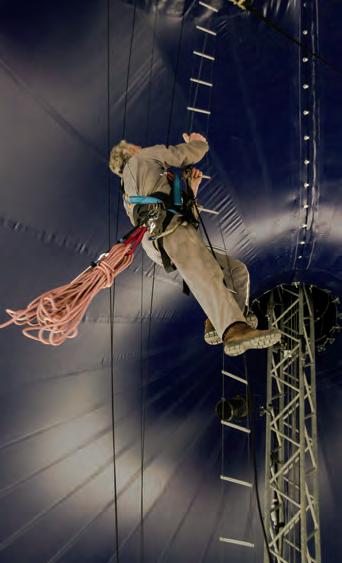
“We selected Sunblock from Dickson Saint Clair for this project, using light gray on the outside and dark blue inside,” Vigne said. “One of the great advantages of Sunblock is its suppleness, which makes it easy to install even in cold weather. Other PVC fabrics tend to become stiff when the temperatures drop. Sunblock is also easy to clean because it includes the Cleangard finish.”
The tent for the French National Center for Circus Arts includes more than 2,000 square meters (21,528 square feet) of Sunblock material.
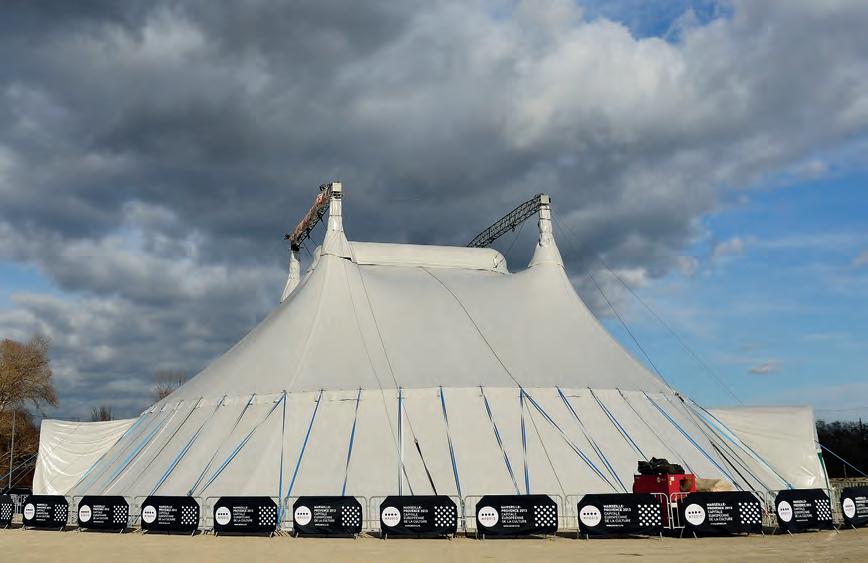
Mondial Chapiteaux and Dickson Saint Clair are frequent collaborators, which is essential for the large and complex structures involved.
“Our relationship with Dickson is simple and direct,” Vigne said. “It’s easy to get in touch with Dickson and discuss technical issues on an equal footing; they know how to listen to their customers and respond in a way that makes the projects go smoothly.”
